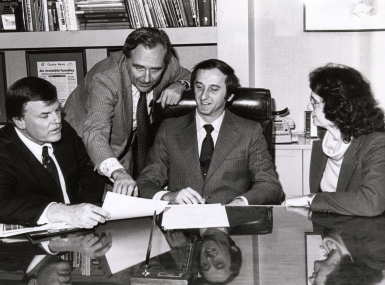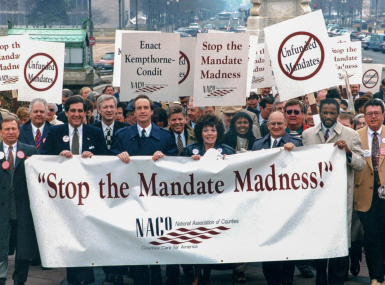Annual Conference kicks off with policy deliberations
Upcoming Events
Related News
NACo’s 83rd Annual Conference in Davidson County/Nashville, Tenn. opened Friday with a full day’s worth of committee meetings. Members of the 10 policy steering committees considered more than 100 policy resolutions. Federal and agency officials were also on hand to brief steering committee members.
Also today: the Next Generation Network held its traditional service project: stuffing backpacks with toiletries and games for families served by the Oasis Center, a nationally-recognized organization serving 3,00 youth and their families in Davidson County.
Following are highlights from several committee meetings.
Watch this space for more updates on the day’s events.
Lack of broadband, cyberattack vigilance top agenda at telecom committee meeting
If you’re a county concerned about broadband in your community, the Federal Communications Commission (FCC) wants to hear from you. “This is a work in progress — let us know if this is something we can help you with, contact us,” urged Elizabeth Mumaw, chief, Office of Intergovernmental Affairs at the FCC.
Speaking to members of NACo’s Telecommunications and Technology Policy Steering Committee, Mumaw discussed the FCC’s Mobility Fund II, which will provide up to $4.5 billion over the next decade to underserved areas. A map released earlier this year by the FCC shows areas of the country presumed eligible to receive support for 4G service. Many have disagreed with the information in the map, which shows that some counties are covered by broadband when they are not.
Cyberattacks
Matthew Travis, deputy undersecretary for the National Protection and Programs Directorate, Department of Homeland Security, said that counties cannot rest easy as election season nears, when it comes to protecting their voting systems from outside cyberattacks. “…in terms of the threats — we’re not seeing that level (from the presidential election) of activity yet, but that doesn’t mean it’s not coming,” he said. Having paper ballot backups are crucial, he noted.
Another big issue facing counties is ransomware attacks, he noted. They “are not a passing phase. Holding counties hostage for not insignificant amounts of money. Essentially you’re going to be faced with a decision of fixing the problem or paying the ransom. We prefer that you not pay the ransom. The best defense is cyber hygiene. A lot of this is preventable.”
Guidelines for testing voting systems could be approved soon
When Brian Newby worked as the election chief for Johnson County, Kan., he wasn’t sold on the Election Assistance Commission, a federal agency he now heads. “I was critical of the EAC because it didn’t speak to me,” he told members of the Finance, Pensions and Intergovernmental Affairs Policy Steering Committee Friday afternoon. “We try really hard … to do things we think are beneficial to election administrators.” Sharing best practices with election administrators, he said, “is a big strength of ours.”
The EAC, which currently only has two commissioners, could soon update guidelines on testing of voting systems, which were last updated in 2007, Newby said. The commission needs three commissioners to approve the new standards, which could happen in a few months once a new commissioner is approved. President Trump recently announced his intent to nominate Donald Palmer, who previously served as an election official in both Florida and Virginia.
Counties should take advantage of the EAC’s Election Administration and Voting Survey (aka EAVS) which does a deep dive into county election data, Newby said. The data allows counties to compare their elections. “In the end we’re a clearinghouse of information,” he said.
EDA has nearly $600 million available to help counties hit by disasters
The Economic Development Administration can help counties that have suffered economically from federally declared disasters get back on their feet, said Dennis Alvord, deputy assistant secretary, Regional Affairs, Economic Development Administration at the Commerce Department.
“EDA has a long history of working with local communities to help with disaster recovery assistance,” he told members of the Community, Economic and Workforce Development Policy Steering Committee at their meeting Friday afternoon.
The EDA has $587 million appropriated to help communities that were hit hard by disasters in 2017, Alvord said. EDA disaster grants are made by its Regional Offices under the agency’s Economic Adjustment Assistance (EAA) Program, which enables EDA to make awards that support a wide range of construction and non-construction activities in areas which experience sudden and prolonged severe economic dislocation.
Education of workforce needs to catch up to number of jobs
The U.S. economy is booming — with 6.6 million open jobs right now — but not enough workers to fill them, said Rosemary Lahasky, acting assistant secretary, Employment and Training Administration, Labor Department.
“The problem is not a lack of jobs, it’s a lack of workers,” she told members of NACo’s Community, Economic and Workforce Development Policy Steering Committee Friday. “Our economy is strong but our system of education is not keeping up. We’re committed to bridging the skills gap.”
One of the solutions, she said, is to simplify the DOL’s apprenticeship program by expanding it to allow industry trade groups to run similar programs. “We look to empower” groups “outside of Washington” to “certify, update and maintain” their own apprentice programs.
Congress answers calls for more opioid abuse funding
There have been a lot of surprises in the opioid addiction crisis, most of them bad. But Tara Kunkel, senior drug policy officer at the Department of Justice’s Bureau of Justice Assistance, had a good one when it came to her grant programs for local governments, she told the Justice and Public Safety Steering Committee.
“I was happily sitting at $13 million last year (for the Comprehensive Opioid Abuse program), and in March got a call that our funding had been increased to $145 million to get out the community,” she said. “Congress really did appropriate a lot more funding that is trickling down, slowly but surely to states and to the local level.”
Aware that that distribution could take longer than counties would like, BJA has created funding categories for counties and tribes, and others for states.
“We’re dedicating a bulk of the money to counties because we want to balance out where the money is going,” Kunkel said.
The funding will be dedicated to addiction treatment for people in jails and first responder diversion training and support programs. She said that eight different “telehealth“ programs were in the works to meet the needs of rural counties that don’t have the capacity to support certain medical services for both addiction and mental and behavioral health problems.
Aging locks threaten inland commerce
Most inland waterway commerce in the United States is assisted by locks and dams, and Waterways Council Government Relations Director Tracy Zea told the Transportation Policy Steering Committee that the 557.8 million tons of products and materials, worth $300 billion, was likely lost on people.
“Rivers are the forgotten R,” the said, explaining that “they’re not road, rail or runway.”
A typical barge can carry the equivalent of 1,050 trucks, and, he added, you probably haven’t had to stop your car to wait for a barge to go by.
The problem, Zea said, is that typical lock systems were built to last 50 years. Almost 60 percent of the 239 U.S. locks are nearly 10 years beyond that point, with many being built in the New Deal era.
“After hitting their life expectancy, the chance of a lock failing increases dramatically,” Zea said, noting that lock failure would drastically increase truck traffic on roads.
The Waterways Council has lobbied for an increase in the fuel tax, which barges themselves would pay, to fund lock improvements and replacements.
Attachments
Related News

Tumultuous ’80s test NACo’s fundamentals
NACo took two entrepreneurial risks in the 1980s — one nearly bankrupted the organization and the other has gone on to pay dividends for more than 40 years.

NACo Board approves new outreach campaign, new affiliate
NACo will launch a public awareness campaign in 2026 promoting the role of county governments to federal policymakers.
